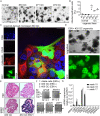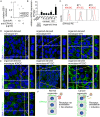Ephrin receptor A2, the epithelial receptor for Epstein-Barr virus entry, is not available for efficient infection in human gastric organoids
- PMID: 33596248
- PMCID: PMC7935236
- DOI: 10.1371/journal.ppat.1009210
Ephrin receptor A2, the epithelial receptor for Epstein-Barr virus entry, is not available for efficient infection in human gastric organoids
Abstract
Epstein-Barr virus (EBV) is best known for infection of B cells, in which it usually establishes an asymptomatic lifelong infection, but is also associated with the development of multiple B cell lymphomas. EBV also infects epithelial cells and is associated with all cases of undifferentiated nasopharyngeal carcinoma (NPC). EBV is etiologically linked with at least 8% of gastric cancer (EBVaGC) that comprises a genetically and epigenetically distinct subset of GC. Although we have a very good understanding of B cell entry and lymphomagenesis, the sequence of events leading to EBVaGC remains poorly understood. Recently, ephrin receptor A2 (EPHA2) was proposed as the epithelial cell receptor on human cancer cell lines. Although we confirm some of these results, we demonstrate that EBV does not infect healthy adult stem cell-derived gastric organoids. In matched pairs of normal and cancer-derived organoids from the same patient, EBV only reproducibly infected the cancer organoids. While there was no clear pattern of differential expression between normal and cancer organoids for EPHA2 at the RNA and protein level, the subcellular location of the protein differed markedly. Confocal microscopy showed EPHA2 localization at the cell-cell junctions in primary cells, but not in cancer cell lines. Furthermore, histologic analysis of patient tissue revealed the absence of EBV in healthy epithelium and presence of EBV in epithelial cells from inflamed tissue. These data suggest that the EPHA2 receptor is not accessible to EBV on healthy gastric epithelial cells with intact cell-cell contacts, but either this or another, yet to be identified receptor may become accessible following cellular changes induced by inflammation or transformation, rendering changes in the cellular architecture an essential prerequisite to EBV infection.
Conflict of interest statement
The authors have declared that no competing interests exist.
Figures






Similar articles
-
Ephrin receptor A2 is an epithelial cell receptor for Epstein-Barr virus entry.Nat Microbiol. 2018 Feb;3(2):1-8. doi: 10.1038/s41564-017-0080-8. Epub 2018 Jan 1. Nat Microbiol. 2018. PMID: 29292383
-
Interferon-induced transmembrane protein-1 competitively blocks Ephrin receptor A2-mediated Epstein-Barr virus entry into epithelial cells.Nat Microbiol. 2024 May;9(5):1256-1270. doi: 10.1038/s41564-024-01659-0. Epub 2024 Apr 22. Nat Microbiol. 2024. PMID: 38649412 Free PMC article.
-
Ephrin receptor A2 is a functional entry receptor for Epstein-Barr virus.Nat Microbiol. 2018 Feb;3(2):172-180. doi: 10.1038/s41564-017-0081-7. Epub 2018 Jan 1. Nat Microbiol. 2018. PMID: 29292384 Free PMC article.
-
Gastritis-Infection-Cancer Sequence of Epstein-Barr Virus-Associated Gastric Cancer.Adv Exp Med Biol. 2018;1045:437-457. doi: 10.1007/978-981-10-7230-7_20. Adv Exp Med Biol. 2018. PMID: 29896679 Review.
-
EBV Infection and Glucose Metabolism in Nasopharyngeal Carcinoma.Adv Exp Med Biol. 2017;1018:75-90. doi: 10.1007/978-981-10-5765-6_6. Adv Exp Med Biol. 2017. PMID: 29052133 Review.
Cited by
-
Cytomegalovirus US28 regulates cellular EphA2 to maintain viral latency.Sci Adv. 2022 Oct 28;8(43):eadd1168. doi: 10.1126/sciadv.add1168. Epub 2022 Oct 26. Sci Adv. 2022. PMID: 36288299 Free PMC article.
-
EPHA2 Receptor as a Possible Therapeutic Target in Viral Infections.Curr Med Chem. 2024;31(35):5670-5701. doi: 10.2174/0109298673256638231003111234. Curr Med Chem. 2024. PMID: 37828671 Review.
-
Progress in Prophylactic and Therapeutic EBV Vaccine Development Based on Molecular Characteristics of EBV Target Antigens.Pathogens. 2022 Jul 30;11(8):864. doi: 10.3390/pathogens11080864. Pathogens. 2022. PMID: 36014985 Free PMC article. Review.
-
Infection of human organoids supports an intestinal niche for Chlamydia trachomatis.PLoS Pathog. 2024 Aug 22;20(8):e1012144. doi: 10.1371/journal.ppat.1012144. eCollection 2024 Aug. PLoS Pathog. 2024. PMID: 39172739 Free PMC article.
-
Organoids as host models for infection biology - a review of methods.Exp Mol Med. 2021 Oct;53(10):1471-1482. doi: 10.1038/s12276-021-00629-4. Epub 2021 Oct 18. Exp Mol Med. 2021. PMID: 34663936 Free PMC article. Review.
References
Publication types
MeSH terms
Substances
Grants and funding
LinkOut - more resources
Full Text Sources
Other Literature Sources
Miscellaneous

